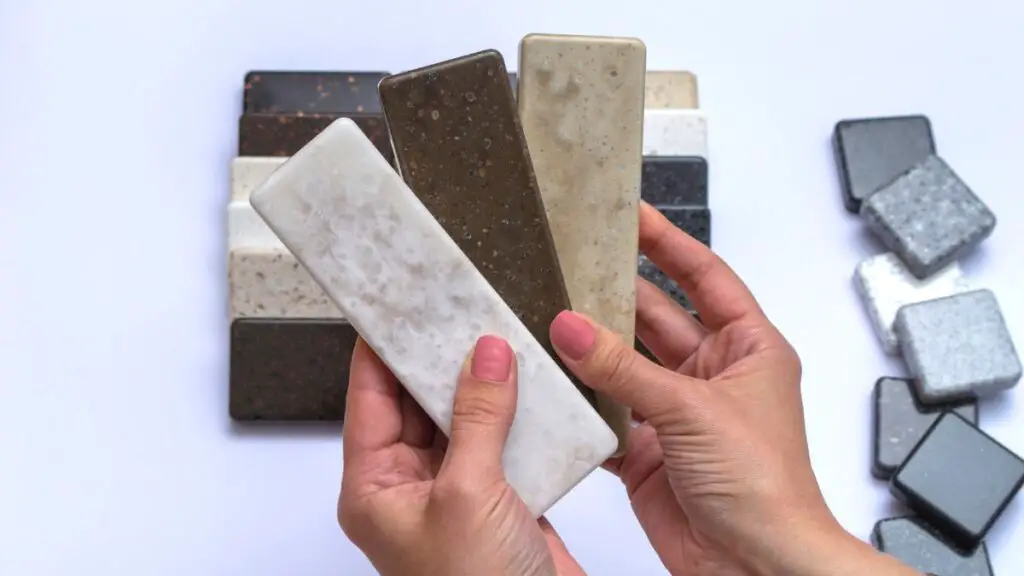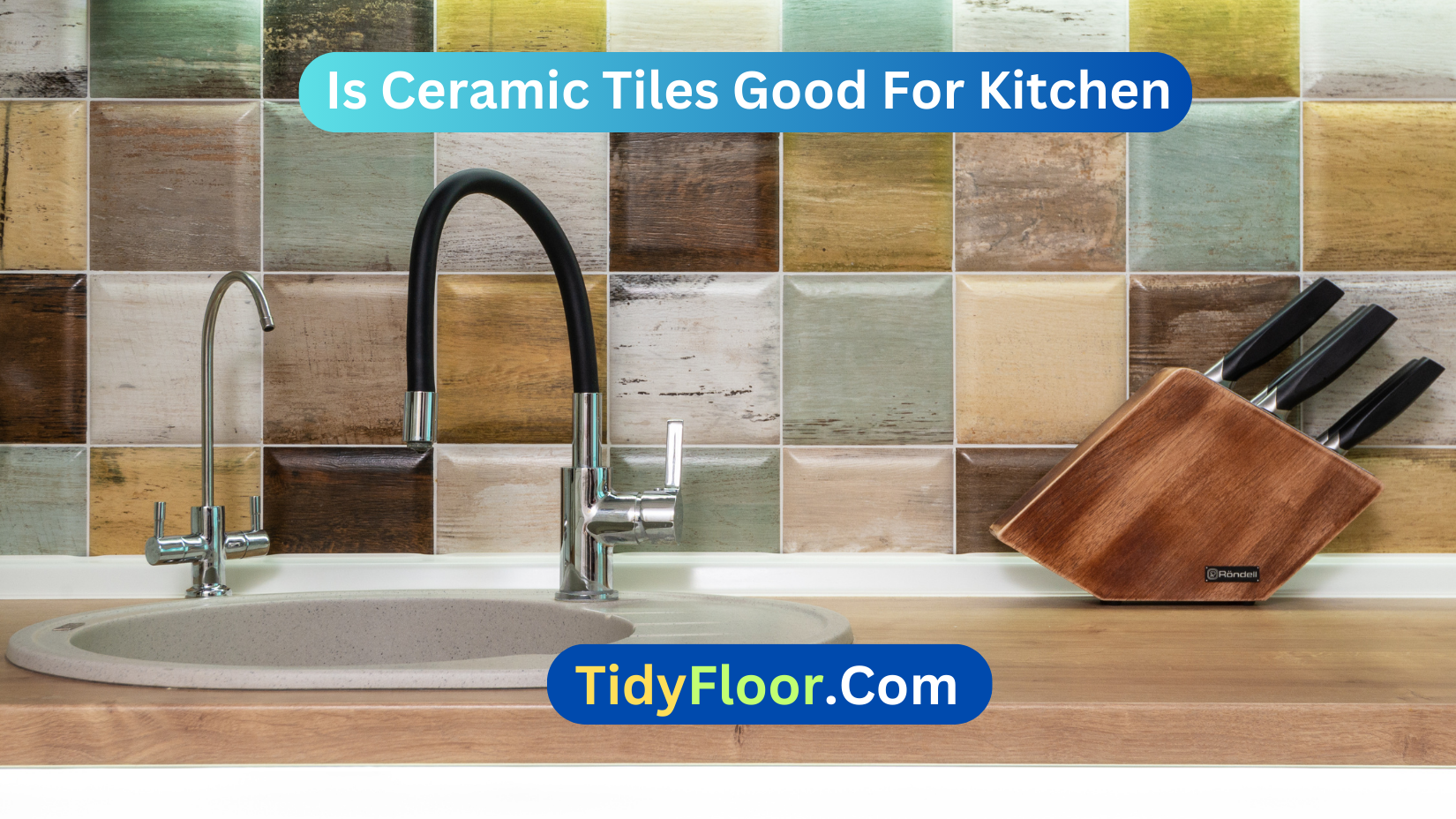If you’re thinking about giving your kitchen a makeover, you might be wondering what kind of materials to use for the floor. Is ceramic tile good for the kitchen?
Is Ceramic tiles good for kitchens. They’re durable, easy to clean, and come in various designs. Their resistance to stains and moisture makes them a popular choice for kitchen floors and backsplashes.
Here, you’ll learn the reasons for using ceramic tiles in the kitchen, maintenance tips for longevity, and some pitfalls. Read further and learn more.
9 Reasons Why Is Ceramic Tiles Good For Kitchen:
Ceramic tiles are a fantastic choice for kitchen surfaces. But why? Discover why ceramic tiles are the ultimate choice for your kitchen.
#1- Durability:
Ceramic tiles are incredibly durable and able to withstand heavy foot traffic, spills, and impacts without easily scratching or chipping. This durability ensures that your kitchen floor or backsplash will last for many years without requiring frequent replacement or repairs.
#2- Stain Resistance:
These tiles have a non-porous surface that makes them resistant to staining. This property is especially beneficial in the kitchen, where spills of food, beverages, and cooking ingredients are common. Ceramic tiles are easy to wipe clean, and stains are less likely to penetrate the surface.
#3- Water Resistance:
Ceramic tiles are inherently waterproof when installed properly. This makes them an excellent choice for areas prone to moisture, such as the kitchen. They are resistant to water damage, including spills, splashes, and humidity. It helps maintain the integrity of the flooring or backsplash over time.
#4- Heat Resistance:
Ceramic tiles can withstand high temperatures, making them suitable for use near stoves, ovens, and other heat sources in the kitchen. Unlike some flooring materials, ceramic tiles will not warp, discolor, or degrade when exposed to heat, ensuring their longevity and appearance remain intact.
#5- Easy Maintenance:
They are low-maintenance and easy to clean, requiring only regular sweeping and occasional mopping with mild detergent and water. Unlike carpets or hardwood floors that can trap dirt and allergens, ceramic tiles offer a smooth, hygienic surface that is easy to keep clean.
#6- Design Versatility:
Ceramic tiles come in a wide variety of colors, patterns, sizes, and textures, allowing for endless design possibilities in the kitchen. Whether you prefer a sleek modern look, a rustic farmhouse style, or a classic timeless design, there are ceramic tiles to suit every taste and aesthetic preference.
#7- Resistant to Fading:
Ceramic tiles are resistant to fading from exposure to sunlight, ensuring that your kitchen floor or back splash maintains its vibrant color and appearance over time. This is particularly important in kitchens with large windows or skylights that receive ample natural light throughout the day.
#8- Hygienic:
The non-porous surface of ceramic tiles makes them inherently hygienic, as they are resistant to the growth of bacteria, mold, and mildew. This makes ceramic tiles an excellent choice for kitchen environments where cleanliness and sanitation are paramount.
#9- Cost-Effectiveness:
They are typically more affordable than many other flooring options, such as hardwood, natural stone, or porcelain. Their combination of durability, longevity, and easy maintenance makes them a cost-effective investment for your kitchen that will add value to your home for years to come.
Maintenance And Cleaning Tips Of Ceramic Tiles In The Kitchen

Learn how to keep your ceramic tile kitchen surfaces looking pristine with these simple maintenance and cleaning tips. Follow these tips to ensure your ceramic tiles stay beautiful for years to come.
Tip 1: Regular Sweeping or Vacuuming
Regularly sweep or vacuum your ceramic tile floors to remove loose dirt, crumbs, and debris. This prevents abrasive particles from scratching the tile surface when walked on.
Tip 2: Mopping with Mild Detergent
Mop your ceramic tile floors with a solution of mild detergent and warm water to remove any dirt or stains. Avoid using harsh cleaning products or abrasive cleaners, as these can damage the tile glaze over time.
Tip 3: Cleaning Spills Promptly
Clean up spills and splatters on ceramic tile surfaces as soon as they occur to prevent staining. Use a clean cloth or sponge dampened with water or a mild cleaning solution to wipe away the spill.
Tip 4: Grout Cleaning
Regularly clean the grout lines between ceramic tiles to prevent the buildup of dirt, grime, and mold. Use a grout brush or an old toothbrush with a mixture of water and baking soda or a mild grout cleaner to scrub the grout lines gently.
Tip 5: Avoid Harsh Chemicals
Avoid using harsh chemicals, bleach, or ammonia-based cleaners on ceramic tiles, as these can damage the tile surface and grout. Stick to gentle, pH-neutral cleaning products to preserve the integrity of your tiles.
Tip 6: Use Mats or Rugs
Place mats or rugs at entryways and high-traffic areas in the kitchen to trap dirt and moisture before they reach the ceramic tile floors. This helps prevent excessive wear and keeps your floors cleaner for longer periods between cleanings.
Tip 7: Protecting Tile Surfaces
Use felt pads or coasters under heavy furniture or appliances to prevent scratching or cracking of ceramic tile floors. Avoid dragging heavy objects across the tiles, as this can cause damage to the surface.
Tip 8: Sealing Grout Lines
Consider sealing the grout lines between ceramic tiles with a grout sealer to protect them from stains, moisture, and mildew. Reapply sealer as needed according to the manufacturer’s recommendations to maintain its effectiveness.
4 Disadvantages Of Ceramic Tiles In Kitchen:

Ceramic tiles are indeed a great option. But they have some pitfalls. Here are four potential disadvantages of ceramic tiles in the kitchen.
1- Susceptibility to Cracking:
Ceramic tiles can crack under heavy impact or if something heavy is dropped on them. While they are durable, they are not as resilient as some other flooring materials like natural stone or vinyl.
2- Maintenance of Grout Lines:
Grout lines between ceramic tiles require regular cleaning and maintenance to prevent staining, mold, and mildew. Grout can also become discolored over time, requiring periodic resealing or regrouting to maintain its appearance.
3- Hardness:
Ceramic tiles are quite hard, which can be uncomfortable to stand on for long periods, especially for those who spend a lot of time cooking or working in the kitchen.
4- Slippery When Wet:
Ceramic tiles can be slippery when wet, posing a potential slip-and-fall hazard, especially in areas prone to spills or near sinks. Using rugs or mats in high-traffic areas can help mitigate this risk.
Related Questions:
Do Ceramic Tiles Resist Stains And Spills In The Kitchen?
Ceramic tiles are resistant to stains and spills in the kitchen. The non-porous surface of ceramic tiles makes them less likely to absorb liquids, preventing stains from penetrating the tile. Spills such as food, beverages, and cooking ingredients can be easily wiped away with a damp cloth or sponge.
It makes ceramic tiles a practical choice for kitchen flooring and backsplashes. However, it’s still important to clean up spills promptly to maintain the appearance and longevity of the tiles.
Are There Different Types Of Ceramic Tiles Suitable For Kitchen Floors Versus Backsplashes?
There are different types of ceramic tiles suitable for kitchen floors versus backsplashes. For kitchen floors, it’s common to use larger, more durable ceramic tiles that can withstand heavy foot traffic and weight from appliances. These tiles are often glazed for added durability and resistance to stains and moisture.
In contrast, ceramic tiles for backsplashes can be smaller in size and come in a variety of finishes and textures to complement kitchen decor. They may also include decorative patterns or accent tiles to enhance the visual appeal of the space.
Are Ceramic Tiles Cost-effective Compared To Other Flooring Options For The Kitchen?
Ceramic tiles are generally considered cost-effective compared to many other flooring options for the kitchen. While prices can vary depending on factors such as tile size, design, and quality, ceramic tiles are often more affordable than materials like natural stone or hardwood.
Also, ceramic tiles are durable, requiring minimal maintenance and offering a long lifespan, making them a wise investment for homeowners looking for both affordability and durability in their kitchen flooring.
Is Ceramic Tile Outdated for Kitchen?
Ceramic tiles are still a popular choice for kitchen flooring and backsplashes due to their durability, versatility, and wide range of design options. Some may consider them traditional. However, advancements in ceramic tile technology have allowed for modern designs and finishes that keep them relevant in kitchen design.
Ultimately, whether ceramic tiles are considered outdated depends on personal preference and the overall aesthetic you want to achieve in your kitchen.
How Long Will Ceramic Tile Last In Kitchen?
The lifespan of ceramic tile in a kitchen depends on various factors such as installation quality, maintenance, and the level of foot traffic. With proper care and maintenance, ceramic tiles can last for several decades.
Typically, you can expect ceramic tiles to remain in good condition for 10-20 years or more in a kitchen environment. Regular cleaning, sealing grout lines, and addressing any issues promptly can help extend the lifespan of ceramic tile flooring or backsplashes in the kitchen.
Conclusion:
Now you may know if is ceramic tile good for the kitchen or not. In the kitchen, where spills, stains, and heavy foot traffic are common occurrences, ceramic tiles offer excellent resistance to wear and tear. Their non-porous surface makes them easy to clean with just a damp mop or cloth, and they are inherently resistant to moisture, stains, and scratches. Their longevity and timeless appeal further enhance their value. Overall, ceramic tile is good for the kitchen if used correctly, and maintained perfectly.


